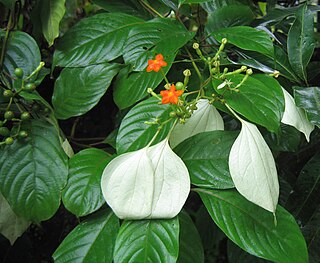
Acanthaceae is a family of dicotyledonous flowering plants containing almost 250 genera and about 2500 species. Most are tropical herbs, shrubs, or twining vines; some are epiphytes. Only a few species are distributed in temperate regions. The four main centres of distribution are Indonesia and Malaysia, Africa, Brazil, and Central America. Representatives of the family can be found in nearly every habitat, including dense or open forests, scrublands, wet fields and valleys, sea coast and marine areas, swamps, and mangrove forests.

Argyreia is a genus of plants in the family Convolvulaceae.

Strobilanthes is a genus of about 350 species of flowering plants in the family Acanthaceae, mostly native to tropical Asia and Madagascar, but with a few species extending north into temperate regions of Asia. Many species are cultivated for their two-lipped, hooded flowers in shades of blue, pink, white and purple. Most are frost-tender and require protection in frost-prone areas. The genus is most famed for its many species which bloom on long cycles of several years, such as Strobilanthes wightii which blooms every thirteen years.

Aeschynanthus is a genus of about 150 species of evergreen subtropical and tropical plants in the family Gesneriaceae. They are usually trailing epiphytes with brightly colored flowers that are pollinated by sunbirds. The genus name comes from a contraction of aischuno and anthos (flower). The common name for some species is lipstick plant, which comes from the appearance of the developing buds emerging from the calyces. A full list of the accepted species and their synonyms can be found in the Smithsonian Institution's World Checklist of Gesneriaceae.

Avicennia is a genus of flowering plants currently placed in the bear's breeches family, Acanthaceae. It contains mangrove trees, which occur in the intertidal zones of estuarine areas and are characterized by its "pencil roots", which are aerial roots. They are also commonly known as api api, which in the Malay language means "fires", a reference to the fact that fireflies often congregate on these trees. Species of Avicennia occur worldwide south of the Tropic of Cancer.

Blepharis is a genus of plant in family Acanthaceae. It contains around 128 species found in seasonally dry to arid habitats from Africa through Arabia to Southeast Asia. In section Acanthodium, there are 13–15 species that use the C4 carbon fixation pathway. Phylogenetic analysis suggests that this pathway evolved up to three times independently in the genus over the last five million years.

Gymnostachyum is a genus of flowering plants in the family Acanthaceae. It includes 50 species native to tropical Asia, ranging from the Indian subcontinent through Indochina to southern China, Peninsular Malaysia, Sumatra, Java, and the Philippines.

Isoglossa is a genus of flowering plants in the family Acanthaceae. It includes 78 species native to tropical Africa, Yemen, the eastern Himalayas, southern China, Indochina, Peninsular Malaysia, Java, Sulawesi, the Lesser Sunda Islands, and New South Wales.

Pseuderanthemum is a genus of plants in family Acanthaceae with a pantropical distribution.
Urophyllum is a genus of flowering plant in the family Rubiaceae, native to from south China to Tropical Asia. The genus was established by Nathaniel Wallich in 1824.

Polyosma is a genus of about 90 species of trees native to south-east Asia. They occur from China south through south-east Asia to the east coast of Australia, New Guinea, the Solomon Islands and New Caledonia.

Argostemma is a genus of flowering plants in the family Rubiaceae. It can be found in (sub)tropical Asia and western and west-central tropical Africa.
Hedyotis (starviolet) is a genus of flowering plants in the family Rubiaceae. Many species of this genus such as Hedyotis biflora, H. corymbosa and H. diffusa are well known medicinal plants. Hedyotis is native to tropical and subtropical Asia and to islands of the northwest Pacific. It comprises about 115 species. The type species for the genus is Hedyotis fruticosa.

Mussaenda is a genus of flowering plants in the family Rubiaceae. They are native to the African and Asian tropics and subtropics. Several species are cultivated as ornamental plants.

Boesenbergia is a genus of plants in the ginger family. It contains more than 90 species, native to China, the Indian Subcontinent, and Southeast Asia.

Sonerila is a genus of plants in the family Melastomataceae. This genus is characterized the by presence of three petals as opposed to five in the other members of the family. Most members of the genus prefer growing in shady habitats. It is a large genus including about 175 species.

Erycibe is a genus of plants in the family Convolvulaceae, found in the Andaman Islands, Sri Lanka, India including Assam, Bangladesh, Myanmar, east Himalaya, southern and southeastern China including Hainan and Taiwan, Southeast Asia, Malesia, Papuasia, Australia, and Japan including the Ryukyu Islands.
Dissochaeta is a genus of plants in the family Melastomataceae. Species can be found in: Hainan and Indo-China through to Malesia.

Rungia is a genus of flowering plants belonging to the family Acanthaceae.















